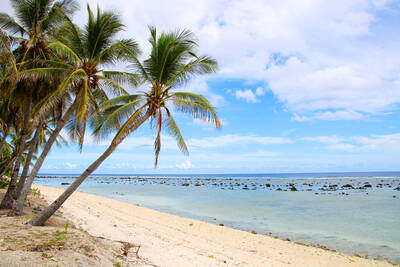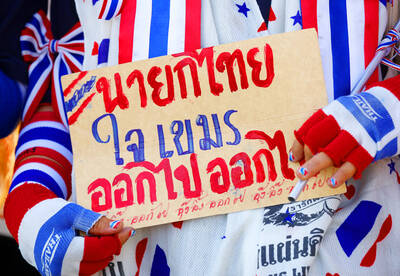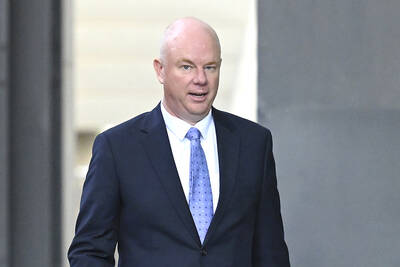For six weeks, in scenes reminiscent of the Palestinian intifada, hundreds of young Kashmiris like 17-year-old Amjad Khan have taken to the streets to pelt stones at Indian security forces.
Government forces have struggled to contain the outpouring of anger triggered by the killing of a schoolboy by police early last month. Protests began in the main city Srinagar and have spread widely.
The unrest marks a new phase in resistance to Indian rule in the disputed territory, some observers believe, revealing the deep frustration of the new generation in the 12-million-strong mostly Muslim population.

PHOTO: REUTERS
In the violence, in which security forces are accused of killing 17 young locals, others see a danger of radicalization in a region that was beginning to emerge from an insurgency that has claimed an estimated 47,000 lives.
“I have taken to stone-throwing to show my anger, my hatred at the present state of affairs,” says the softly spoken Khan (name changed), as he stands in one of Srinagar’s narrow back streets.
The son of a government employee father, who disapproves of his behavior, Khan is dressed casually in jeans and a T-shirt and has his hair gelled in a style familiar from Indian Bollywood films.
He says he is not a particularly devout Muslim and attends Friday prayers only to be able to join the regular protests that take place afterwards, denouncing Indian rule in the territory.
Born during the insurgency like most of the under-20 protestors — tech-savvy Internet users who are harnessing Facebook and YouTube to highlight their struggle — he has known nothing but violence and turmoil in Kashmir.
“Why should this problem linger on if so many other problems have been resolved?” he asks.
When the subcontinent was divided in 1947, Kashmir’s Hindu leader opted to take his mainly Muslim subjects into Hindu-majority India rather than Pakistan and the two neighbors have since fought two wars over the territory.
Kashmir is divided into Indian and Pakistani-controlled regions, with both countries claiming the territory.
For two decades from 1989, a violent anti-India insurgency raged in the Indian part, making it one of the most dangerous places on the planet in the mid-1990s. The intensity of the attacks has waned significantly in recent years, widely attributed to the start of peace talks between India and Pakistan in 2004.
Before the latest wave of unrest, there was talk of major troop withdrawals and revival of the region’s main economic activity, tourism.
The government in New Delhi has tried to paint the protests as the work of shadowy Pakistani extremists, but many local leaders believe the underlying reason is despair among the young generation about their prospects.
There are more than 400,000 unemployed young people across the state and decades of on-off political dialogue about the status of the territory have yielded few rewards and no end to the deadlock.
Some pro-India parties call for autonomy for the region, moderate separatists seek independence and hardliners continue to campaign for a merger with Pakistan.
“The single largest factor today is that people don’t see the light at the end of the dark tunnel they were hoping to see,” the state’s chief minister, Omar Abdullah, admitted on Indian news channel NDTV earlier this month. “Until we resolve it politically we will always have problems.”
A wave of protests, which observers date back to mid-2008 when the state government attempted to transfer a piece of land to a Hindu shrine, reveal this frustration.
Indian army chief General V.K. Singh said last month that the battle against anti-India insurgents had been more or less won, but people needed to feel that progress was being made to improve their lives.
“Militarily, we have brought the overall internal security situation in Jammu and Kashmir under control. Now, the need is to handle things politically,” Singh told the Times of India.
He added that he felt “a great requirement for political initiatives that take all people together.”
In New Delhi, Indian Home Minister P. Chidambaram has pushed the notion that the protests are being orchestrated by militant groups and Pakistan. He has sanctioned a crackdown, with the army out on the streets, text messages banned to disrupt communication between protestors and strict curfews in place across most of the region.
He has also pointed the finger at the Pakistan-based Lashkar-e-Toiba militant group, which India blamed for the 2008 Mumbai attacks that left 166 people dead.
“Linking the genuine anger and anguish among people with terrorism is nothing short of an assault on their self respect and dignity,” said Mufti Sayeed, former chief minister of the pro-India People’s Democratic Party.
Mehboob Beigh, who advocates autonomy in the region, agrees. Political alienation of Kashmiris is the larger issue, he said.
“Our youth want to be heard. New Delhi should listen to them with compassion and sincerity or we may soon see another cycle of violence,” Beigh said.

Nauru has started selling passports to fund climate action, but is so far struggling to attract new citizens to the low-lying, largely barren island in the Pacific Ocean. Nauru, one of the world’s smallest nations, has a novel plan to fund its fight against climate change by selling so-called “Golden Passports.” Selling for US$105,000 each, Nauru plans to drum up more than US$5 million in the first year of the “climate resilience citizenship” program. Almost six months after the scheme opened in February, Nauru has so far approved just six applications — covering two families and four individuals. Despite the slow start —

YELLOW SHIRTS: Many protesters were associated with pro-royalist groups that had previously supported the ouster of Paetongtarn’s father, Thaksin, in 2006 Protesters rallied on Saturday in the Thai capital to demand the resignation of court-suspended Thai Prime Minister Paetongtarn Shinawatra and in support of the armed forces following a violent border dispute with Cambodia that killed more than three dozen people and displaced more than 260,000. Gathered at Bangkok’s Victory Monument despite soaring temperatures, many sang patriotic songs and listened to speeches denouncing Paetongtarn and her father, former Thai prime minister Thaksin Shinawatra, and voiced their backing of the country’s army, which has always retained substantial power in the Southeast Asian country. Police said there were about 2,000 protesters by mid-afternoon, although

MOGAMI-CLASS FRIGATES: The deal is a ‘big step toward elevating national security cooperation with Australia, which is our special strategic partner,’ a Japanese official said Australia is to upgrade its navy with 11 Mogami-class frigates built by Japan’s Mitsubishi Heavy Industries, Australian Minister for Defence Richard Marles said yesterday. Billed as Japan’s biggest defense export deal since World War II, Australia is to pay US$6 billion over the next 10 years to acquire the fleet of stealth frigates. Australia is in the midst of a major military restructure, bolstering its navy with long-range firepower in an effort to deter China. It is striving to expand its fleet of major warships from 11 to 26 over the next decade. “This is clearly the biggest defense-industry agreement that has ever

DEADLY TASTE TEST: Erin Patterson tried to kill her estranged husband three times, police said in one of the major claims not heard during her initial trial Australia’s recently convicted mushroom murderer also tried to poison her husband with bolognese pasta and chicken korma curry, according to testimony aired yesterday after a suppression order lapsed. Home cook Erin Patterson was found guilty last month of murdering her husband’s parents and elderly aunt in 2023, lacing their beef Wellington lunch with lethal death cap mushrooms. A series of potentially damning allegations about Patterson’s behavior in the lead-up to the meal were withheld from the jury to give the mother-of-two a fair trial. Supreme Court Justice Christopher Beale yesterday rejected an application to keep these allegations secret. Patterson tried to kill her